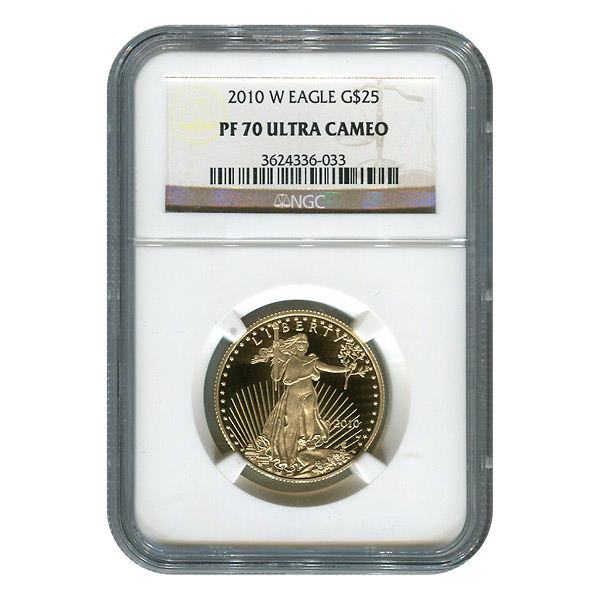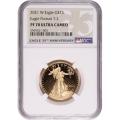Half Ounce Certified Proof Gold Eagles

The Proof American Gold Eagles were minted, in just 1 oz increments, in 1986. By 1988, the Proof American Gold Eagle Coin became available in four sizes: 1 oz, 1/2 oz, 1/4 oz, and 1/10 oz. Unlike the brilliant uncirculated coins, that are only packaged in tubes of 10, the Proof American Gold Eagle's packaging is more aesthetically pleasing. The coin itself is encased in an appropriately fitted capsule then placed into a velvet presentation box with its Certificate of Authenticity. The presentation box is then protected by an official US Mint cardboard box.
The American Gold Eagle minting process varies slightly depending on the ideal finish of the coin. There are three finishes offered for the American Gold Eagle Bullion coins: Brilliant Uncirculated, Proof, and Burnished. The Burnished finish is only offered in 1 oz increments when production was halted in 2009, prohibiting other sizes to be minted to save money. The Proof American Gold Eagle has been minted alongside its Brilliant Uncirculated counterpart since 1986.
Background of the American Gold Eagle
Many people confuse the American Gold Eagles with the "double eagles" of the Pre-1933 gold coin program. The double eagles are the $10 gold coins that once held the title of highest monetary value gold coin. In the 1820's and 30's, Congress was asked, on multiple occasions, to authorize the minting of a new gold coin. During the famous gold rushes, there were very large transactions taking place that would leave traders and prospectors with pockets full of small denomination gold coins. This system was neither safe or ideal for anyone so a larger denomination gold coin was the only answer. The $20 Liberty was first produced in 1850, maintaining its design until 1907, when the $20 Saint-Gaudens design took over.
The American Gold Eagles are the first gold coins to be minted since 1933, in the United States. When the Gold Bullion Act of 1985 was passed, the legislation demanded that there would be four weight sizes offered and two different types of coins minted. This resulted in the American Gold Eagle containing the 1 oz, 1/2 oz, 1/4 oz, and 1/10 oz in sizes. There were also two conditions minted, brilliant uncirculated and proof (although the proof condition was only offered in 1 oz increments at first). The legislation also specified that the precious metals used, in the making of the American Gold Eagle, would come from US mines.
Design History of American Gold Eagles
Reimagined by sculptor, Miley Busiek, the design of the US American Gold Eagle features the most iconic US coin design. The obverse follows the artistic design created by Augustus Saint-Gaudens, for the $20 Gold Double Eagles, issued from 1907-1933. Saint-Gaudens was exclusively picked by president, Theodore Roosevelt, to design an image that would be a part of US history, while also reinvigorating US gold coinage. The Lady Liberty design has been used as a symbol of patriotism since the US began minting their own currency and her message of courage and power still reigns true.
The design features a fierce Lady Liberty carrying an olive branch in one hand and an ignited torch in the other. The olive branch represents the country's desire for ultimate peace. The torch is the symbol of enlightenment and has been used, in the United States, as a means to freedom and liberty; enlightenment births freedom. Lady Liberty is stressed in a loose and flowing robe, marching with the US Capital building behind her. Next to her is the coin's date of mintage; from 1986-1991, the coin's date was cast in Roman Numerals, instead of the familiar Arabic Numeral System. Along the rim are 50 stars, each representing a US state, a design that has been used on other emblematic US coins, such as the Morgan Silver Dollar. The original design featured only 46 stars, since that was how many states existed from 1907-1933.
The reverse displays the emblem of the nation, hand-picked by the Founding Fathers. The bald eagle is the king of the birds of prey and represents fierce beauty, strength, and independence. There are 3 bald eagles represented on the reverse design of the American Gold Eagle. The eagles have made a nest of olive branches and have started reproducing, with an infantile eagle represented under its mother. The coin's weight, purity, and monetary value are written underneath the eagle family.
Certified Proof American Gold Eagles
Certified coins are placed in airtight, official holders, marked by the grade they received and the name of the certifying grading agency. Since Certified coins' condition is more specified than a Non-Certified coin, their value can greatly increase. Collectors and numismatists appreciate Certified coins since most of the work is done for them and they can just reap the benefits of owning a Certified coin.
There are many coin grading agencies out there but only two that are revered worldwide. The Numismatic Guaranty Corporation (NGC) and the Professional Coin Grading Service (PCGS) are two companies that issue coins their grades. These companies not only certify coins, but they also encase the graded coin into an official holder, preserving the coin and marking the holder with its earned grade. This alone has changed the coin collecting game, while also offering a peace of mind for collectors and investors.
Sheldon Numeric Scale
Learning about the Sheldon Numeric Scale isn't necessarily a priority for investors but can deem useful when looking to purchase Certified American Gold Eagles. Dr. William Sheldon was an American psychologist by trade and a numismatist as a hobby. In 1948, Sheldon developed the Sheldon Numeric Scale, which became the foundation of grading and certifying coins. The Sheldon Numeric Scale dictates that a coin's condition can fall between 1 and 70. Before this groundbreaking system, coins were graded mostly by physical appearance and could receive one of three grades.
Terms for the Certified American Gold Eagle
- MS: Short for "Mint-State;" refers to coins that have never been in circulation and are the same condition as when they were originally produced. Mint State coins will receive a grade ranging from 60-70 on the Sheldon Numeric Scale.
- PF/PR: Abbreviation for "Proof;" refers to the method of coin manufacture, made for eye appeal among collectors.
- SP: A "specimen" coin is a combination of strike type (somewhere in the middle of Mint State and Proof).
- MS/PF70: Bullion coins that have kept their original mint luster and contain zero post production flaws.
- MS/PF69: Bullion coins that contain 2 or less minute imperfections but still carry their original mint luster.
- First Strike: PCGS term designates coins that have been certified within the first 30 days of production by the contributing mint.
- Early Release: NGC term designates coins that have been certified within the first 30 days of production by the contributing mint.
- UCAM/DCAM: Shortened for Ultra-Cameo and Deep-Cameo, these terms refer to the coin's visual brilliance that is apparent on the surface by an unyielding, frosted finish and a deeply mirrored background luster.
Highest Mintages
Proof American Gold Eagles take longer to make so there are not produced according to the demand in the market. Compared to the Brilliant Uncirculated American Gold Eagles, the Proof versions collectively have much lower mintages each year. Here are the highest minted 1/2 oz Proof American Gold Eagles in the series.
- 1987-143,398
- 1988-76,528
- 1991-53,125




4280.jpg)
7427.jpg)
9917.jpg)
94.jpg)
95.jpg)
416.jpg)


